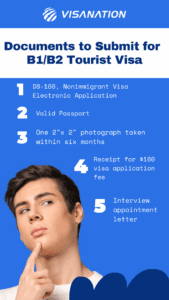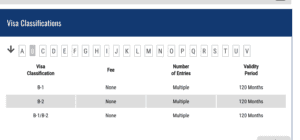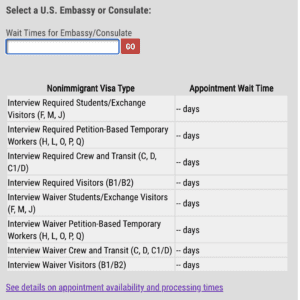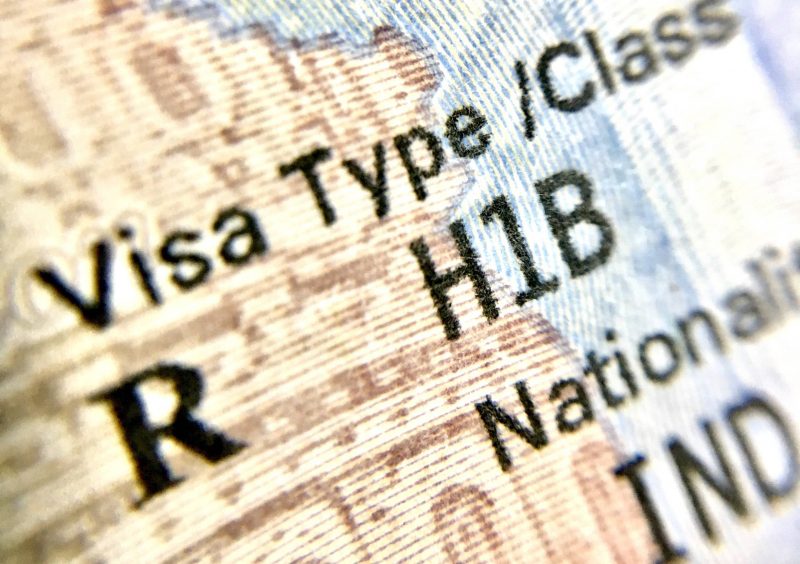Get B-1 and B-2 Visas to Visit the U.S.
If you’d like to visit the United States for a vacation, a short trip for business, to visit family or friends, or for medical treatment as a foreign national, then you’ll need to apply for a visitor visa (B-1/B-2). A B-1 visa is designed for those wanting to do business with a company while in the U.S. A B-2 visa is designed for those who want to come for the purpose of pleasure or general tourism. In this complete guide, we’ll go over the steps to apply for a tourist visa, general processing time, and other helpful tips!
Difference Between B-1 and B-2 Visa
As previously mentioned, the main difference between the B-1 and B-2 visa is that the B-1 visa is intended for travel including:
- Carrying out business (i.e., business meetings, negotiating contracts, etc.)
- Going to a professional conference for the purpose of further education or related to business
- Settling an estate
On the other hand, a B-2 visa is for foreign nationals who want to temporarily vacation in the U.S. or obtain medical treatments.
In order to qualify for either of these visas, you will need to demonstrate that the nature of your trip is a temporary visa (you plan to stay for a limited period of time), you have the financial means to pay for your expenses while in the United States, and you have ties to your home country including a residence and economic ties that ensure you will be returning.
Under a travel visa, certain activities are not allowed, including studying, engaging in long-term employment with a U.S. company, performing for a paying audience, arriving as a crewmember on a ship or aircraft, working in the foreign press, such as radio, film, or print journalism, or seeking permanent residency in the United States. The max time a B visa can be issued is 180 days.
Check out this page: How to Write an Invitation Letter for U.S. Visa
Visa Waiver Program
Nationals from select countries are eligible to participate in the Visa Waiver Program, which allows them to travel to the United States for business, tourism, or transit purposes for a maximum of 90 days without requiring a visa. To date, there are 40 countries in which citizens can travel to the U.S. for tourism or business for up to 90 days without a visa. Those countries are:
- Andorra (1991)
- Australia (1996)
- Austria (1991)
- Belgium (1991)
- Brunei (1993)
- Chile (2014)
- Croatia (2021)
- Czech Republic (2008)
- Denmark (1991)
- Estonia (2008)
- Finland (1991)
- France (1989)
- Germany (1989)
- Greece (2010)
- Hungary (2008)
- Iceland (1991)
- Ireland (1995)
- Italy (1989)
- Japan (1988)
- Korea, Republic of (2008)
- Latvia (2008)
- Liechtenstein (1991)
- Lithuania (2008)
- Luxembourg (1991)
- Malta (2008)
- Monaco (1991)
- Netherlands (1989)
- New Zealand (1991)
- Norway (1991)
- Poland (2019)
- Portugal (1999)
- San Marino (1991)
- Singapore (1999)
- Slovakia (2008)
- Slovenia (1997)
- Spain (1991)
- Sweden (1989)
- Switzerland (1989)
- Taiwan (2012)
- United Kingdom** (1988)
According to DHS, the citizens of the new countries of Curacao, Bonaire, St Eustatius, Saba and St Maarten (the former Netherlands Antilles) are not eligible to travel to the United States under the Visa Waiver Program if they are applying for admission with passports from these countries.
Tourist visas are also not usually required for Canadian nationals entering the US. However, when studying, working, or moving permanently to the United States, Canadians must obtain the appropriate visa.
Documents to submit for a business or tourist visa:
- DS-160, Nonimmigrant Visa Electronic Application
- Valid passport (with validity at least six months beyond the intended period of stay in the U.S.)
- One 2″x 2″ photograph taken within six months
- Receipt showing you’ve paid the $160 non-refundable nonimmigrant visa application processing fee
- Interview appointment letter confirming that you booked an appointment
Steps in the Application Process
Step 1: Fill out the Nonimmigrant Visa Electronic Application (DS-160) form.
Step 2: Submit the visa application fee.
Step 3: Use this web page to schedule your appointment. You will need the following information:
- Your passport number
- The CGI reference number from your Visa Fee receipt (click here if you need help finding this number).
- The ten (10) digit barcode number from your DS-160 confirmation page.
Step 4: Attend your visa interview at the U.S. Embassy on the scheduled date and time. Make sure to bring a printed copy of your appointment letter, your DS-160 confirmation page, a photograph taken within the past six months, and all of your current and previous passports. Your application will not be accepted if any of these items are missing.
Scheduling a Visa Interview
This is not required for all visa applicants. If you are age 13 or younger, an interview is not generally required (check with your attorney if this is the case). If you are 14-79 an interview is generally required, and if you are age 80 or older, an interview is generally not required. To obtain your visa, it’s highly advised to make an appointment for an interview at the U.S. Embassy or Consulate in your country of residence. Although it is possible to schedule the interview at a different U.S. Embassy or Consulate, bear in mind that it could be more challenging to meet the visa requirements outside your country of residence. As interview waiting times vary depending on location, time of year, and visa category, it is recommended to apply for your visa well in advance.
Tourist Visa Cost
The cost for a B-1/B-2 visa is $160 (if one is required based on your country of nationality). If you use the assistance of an attorney, this does not include the fees they may charge or the cost to acquire passport photos either.
You can use State Department’s visa issuance fee calculator, which is a really convenient tool. Simply select your nationality to see the issuance fee. For example, if you type in Canada, and on the following page go to the letter B in the chart, you will see the fee says none and the validity period says 120 months.
Average Wait Time for Tourist Visa
The answer to this question depends largely on the wait time for your specific embassy or consulate. To get the most accurate answer, use the wait time tool located on the State Department website. Enter your city, for example, Mumbai (Bombay) has an appointment wait time of 352 calendar days for interviews required for B-1/B-2 applicants and a wait time of 37 calendar days for interview waiver visitors [as of March 31, 2023]. Not all countries have as long a wait time. If you type in Prague, the appointment wait time for B-1/B-2 applicants is 56 days.
Check out B-1/B-2 to H-1B Change of Status
Extending Your Stay in the United States on B-1/B-2
In order to extend your stay (on a B-1 or B-2 visa), you will need to file Form I-539, Application to Extend/Change Nonimmigrant Status with USCIS. It’s recommended that you apply to extend your status at least 45 days before your authorized stay expires. You will also need to provide evidence that shows why you need to extend your stay (i.e., medical reasons or unexpected circumstances). If your application is approved, you may be granted an extension of up to one year. If you find yourself in a situation where you need to extend your stay were strongly recommend doing so alongside a qualified immigration attorney.
B-1 and B-2 Frequently Asked Questions
Below you will find answers to the most commonly asked questions about this topic:
What is the difference between a B-1 visa and a B-2 visa?
A B-1 visa is intended for short business trips, while a B-2 visa is for tourism purposes such as visiting family or going on vacation. You can see the full breakdown of the difference in the section above.
Who is eligible for a B-1/B-2 visa?
Individuals who plan to visit the United States temporarily for holiday or work purposes, such as attending a conference or touring a place, can apply for a B-1/B-2 visa. However, they will typically be required to provide proof of ties to their home country and intention to leave the United States.
What is the maximum duration of stay on a B-1/B-2 visa?
Upon arrival in the United States, a customs officer will grant a stay for up to six months. If you’d like to stay past that, a one-year extension may be requested through the filing of Form I-539 to extend or change your status.
Is it possible to work in the United States with a B-1/B-2 visa?
No, the B-1/B-2 visa does not allow an individual to work or be employed by a U.S. employer. For work purposes, other visa categories, such as the H-1B visa, may be suitable.
How can I renew my B-1/B-2 visa?
To renew a B-1/B-2 visa, the original application process must be completed. In some cases, a visa renewal may be possible without an interview.
Is the ESTA a suitable alternative to the B-1/B-2 visa?
For citizens of the 38 countries in the Visa Waiver Program, the ESTA is an alternative to the B-1/B-2 visa. Although it allows entry for tourism or business purposes, it only permits a stay of up to 90 days. The B-1/B-2 visa is an option for those who wish to stay in the US for a longer period.
Do Canadian citizens require a B-1/B-2 visa?
Most Canadian citizens do not need to apply for a visa for casual business or tourism travel and are automatically granted entry into the U.S. under the B-1/B-2 visa category.
Is the B-1/B-2 visa an immigrant or non-immigrant visa?
The B-1/B-2 visa is a non-immigrant visa, but it may be possible to transition from a visitor visa to a green card if circumstances change, such as marrying a US citizen or permanent resident. Boundless can assist with this process.
What is not allowed on a visitor visa?
The following are prohibited activities that would require you to apply for a different type of visa:
Understanding the differences between the B-1 and B-2 visas is important for anyone planning a trip to the U.S. Whether you’re traveling for business or pleasure, knowing the eligibility requirements and how to extend your stay can save you time and hassle.









.png)